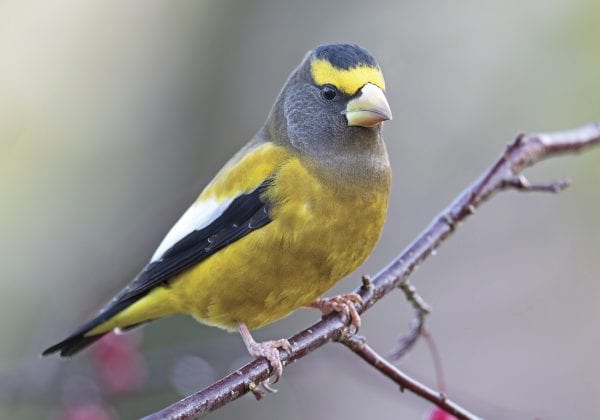
BIRDWATCH
By John Thaxton
The first time I saw an evening grosbeak I experienced a neck-snapping déjà vu as I visualized a brilliantly yellow 1956 Ford Thunderbird with a black convertible top that a neighbor used to park immediately outside my bedroom window. When I opened my eyes in the morning I saw the Thunderbird, which gave me quite a bit of pleasure, and when I saw my first evening grosbeak my jaw dropped, I could swear, all the way down to the ground. Not simply black and yellow, the evening grosbeak has a white greater covert that looks exactly like the whitewall tires on that Thunderbird.
Even though the Thunderbird didn’t have any feathers, nor the evening grosbeak any hubcaps, I never managed to dissociate the automobile and the bird. Still, I’ve managed never to mention it, until just now.
The ornithologist who collected the first specimen of evening grosbeak believed, incorrectly, that the bird sang only in the evening. They sing throughout the day but during morning and afternoon tend to sing near their nest, which they locate very high in a tree, making it very difficult to hear 70 feet down. The scientific name, Fringilla vespertina, means “finch of the evening.”
An irruptive species that moves down from Canada to the coterminous states when its food species (in particular spruce budworms) crashes, evening grosbeaks tend to move in small flocks of 20 or so. They make quite a bit of noise when they show up and they can empty a bird feeder very quickly. I saw my first evening grosbeak at my feeder, and within 10 minutes 18 other grosbeaks arrived and emptied the feeder in less than half an hour.
Then they took off, only to return 20 minutes after I refilled the feeder and put out another one. They prefer black oil sunflower seeds, and lots of them.
About a month before they begin to breed, groups of four to 10 birds separate from the larger flock and pairs begin to form. The males, who make no vocalizations, display by crouching so low their breasts almost touch the ground, they sometimes quiver and they spread their wings downward. Females beg for food, stretching their necks upward, spreading their tails and fluttering their wings. The male offers seeds to the female, and this ritual continues throughout the breeding season.
The strength of the pair bond becomes apparent when banders trap a female evening grosbeak—the male positions himself immediately beside the trap, and even goes inside if the female does, and defends his female against any other male grosbeaks looking for a mate.
The Finch Research Network issued an evening grosbeak alert in late October of this year, noting that this apparently seems a spectacularly good year for an irruption. Look for them at feeders, and keep yours filled with black oil sunflower seeds, which they can devour in record times.
I remember hearing a wild cacophony of bird calls, which I didn’t recognize, and looking out the window to see a flock of evening grosbeaks going hog wild on my bird feeder. I had never seen one before, and I remember looking at my field guide, looking at the birds and wondering, well, at the absolutely incredible beauty of nature, and of a bird that eats sunflower seeds like they were going out of style.
You can see evening grosbeaks just about anywhere, and when they show up you will hear them holding forth. So keep your feeders filled.
"all day" - Google News
February 01, 2021 at 06:54PM
https://ift.tt/2MJOUB8
Evening grosbeaks, all day long - Adirondack Explorer
"all day" - Google News
https://ift.tt/35pEz2D
Bagikan Berita Ini














0 Response to "Evening grosbeaks, all day long - Adirondack Explorer"
Post a Comment